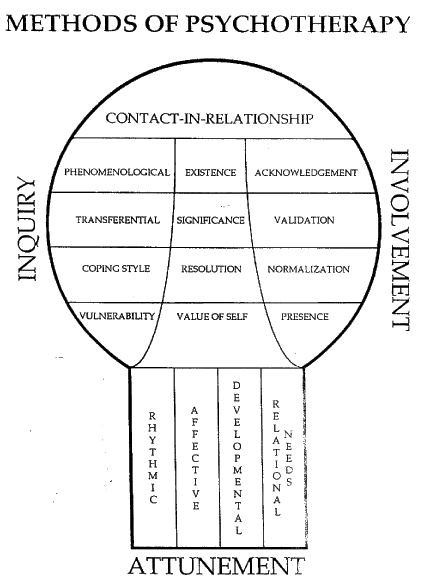Above is one model of
integrative psychotherapy (Erskine and Trautmann, 1996). What follows below are some preliminary thoughts on how I practice as a therapist and how I might change the existing nomenclature to reflect a more client-centered, relational model that rejects pathologizing language and structures (i.e., the DSM).
Premise:
What counselors and psychotherapists have been taught to identify as symptoms of a corresponding condition pejoratively defined as "mental illness" should rather be understood as
adaptations to experience.
All adaptations are at their genesis
the best available mechanism for survival. As a person ages, these adaptations become either skillful (healthy) or unskillful (not supporting physical, emotional, mental, and spiritual health).
Disclaimer:
Short-term responses to challenging situations are not, in general, to be seen as adaptations to that experience (i.e., normal human emotional responses to life events such as death of a loved one, losing a job or promotion, surviving an accident, and so on). If, however, there are several similar experiences over a person's lifetime, with a corresponding response pattern that has solidified into what Carl Jung defined as a "complex," then this then can be seen as an adaption and not a response.
Diagnosis:
When we join a new client on their healing journey, our task is to identify with them the somatic symptoms, affect dysregulation, cognitive distortions, lost spirituality, the core beliefs, and each domain's corresponding defense mechanisms that block an integrative experience of full health.
An integrative approach assesses from (at least) five domains, four of which are addressed by specific models of psychotherapy that contend their model is the only necessary model:
- Body - somatic symptoms and unconscious behaviors
- Affect - ability to regulate affect and for affect to match verbal and behavioral expression
- Cognitive - possessing rational and non-distorted self-concepts, lack or pervasive thinking errors, or other forms of unskillful cognitive and behavioral scripts
- Spiritual - a sense of purpose and meaning in one's life whether it's religious, spiritual, or atheist/humanist
The fifth domain is the
Core Beliefs a person holds about who s/he is and what other people believe about him or her. These beliefs are deeply held and generally unconscious. They tend to originate in infancy and early childhood, making them difficult to uproot in order to plant new seeds for healthier core beliefs. Further, core beliefs tend to manifest in each of the four other domains listed above.
Multiplicity
We are all born (barring organic defects) with a whole and healthy Self-seed (our genetic and characterological template) that will become a mature sense of Self. However, no one escapes childhood without that Self being compromised in some way. Some children are so abused and/or neglected that they
never develop a solid sense of self.
Consequently, parts of the self that are either overwhelming (emotional responses to trauma), unsafe (natural behaviors that are punished by caregivers), or not nurtured (for example, capacity for compassion or generosity) are split off from the Self and become self-fragments, ego states, parts, or subpersonalities that often remain unconscious and tend to show up in various forms of projection.
For each split off part, there is a part or parts that manages the outside world in some way to keep those "exiled" parts out of consciousness. Some of the common "managers" are the
Pusher (focused on achievement and constant movement toward the next goal),
Perfectionist (all or nothing thinking, a need for personal perfection, the failure of which brings intense shame),
Pleaser (often middle children or first children who try to make everyone else happy, often at the expense of their own happiness), and the
Inner Critic (a part who seeks to ensure the client is never criticized by others by being so hyper-critical of the client that any other criticism will be avoided).
In order for splitting to become "hard-wired," there must be repeated episodes of the experiences that lead to the splitting. Normal misattunement between child and caregiver will not lead to splitting and, in fact, such misattunements are necessary for the development of resilience when they are quickly repaired by the caregiver.
Worldviews or Reality Frames
It is incumbant upon the therapist to be "experience near" (Kohut) with the client and be able to identify their basic worldview or reality model. This does not mean that the therapist necessarily supports the client's worldview, however, but it does require that the therapist be able to work within that reality frame.
It's also important that a client's worldview be held lightly - different parts of the client will possess alternate worldviews with anywhere from slight to profound variations.
Likewise, when a therapist encounters a new client whose worldview is unfamiliar (for example, someone from another country, or members of Tribal Nations, and so on), it is essential that therapists educate themselves as best they can and that they inquire with the client when they start to make assumptions about the client's experience that may not fit their reality frame.
Models of Psychotherapy
Successful therapeutic interventions require the all five domains are addressed. Here are a few examples of the therapeutic models that address the various domains:
Body - nutrition, exercise, somatic therapies (Somatic Experiencing, Bioenergetics, Yoga Therapy), behavioral psychotherapies, mindfulness-based therapies, Internal Family Systems Therapy (IFS - "parts work"), Hakomi, Eye Movement Desensitization, and Reprocessing (EMDR)
Affect - affective neuroscience, interpersonal neurobiology, intersubjective and relational psychotherapies, mindfulness-based therapies, IFS
Cognitive - cognitive behavioral therapies (CBT), dialectical behavioral therapy (DBT), neurolinguistic programming (NLP), rational emotive behavioral therapy (REBT), script analysis (Transactional Analysis), existential psychotherapy, narrative therapy, IFS
Spiritual - transpersonal psychotherapy, Jungian Analytical Psychotherapy, contemplative practices, meta-narrative therapies, existential psychotherapy, IFS (developing "Self-Leadership"), expressive therapies
Core Beliefs - cognitive therapies, relational psychotherapies, IFS, narrative therapies, creative visualization, soul retrieval, expressive therapies
Undoubtedly, there are other models I am not familiar with or that have slipped my mind at the moment, so this list should not be taken as my final position on this topic.
Goals of Psychotherapy
First rule: Do No Harm.
Second rule: It's not the therapy, it's the relationship.
If therapists can successfully follow these two rules, and hold a belief in the inherent ability of the client to heal, as well as a belief in the client's ability to know what therapeutic pace and which interventions are best for them, then the client becomes his or her own healer and the therapist simply "midwife" that process with them.
The goal is never to impose a therapist's sense of "mental health" but, rather, to explore with the client what their own sense of mental health looks like and feels like in their lives. Having done so, then it becomes easier for the therapist to identify with the client which areas or domains of their life are not functioning optimally.
Areas of less-than-optimal function are the adaptations defined as unskillful that therapy seeks to minimize while also helping the client learn skillful adaptations to replace those being minimized.
***
Okay then, that is my first-pass at a new model. Please share your thoughts, comments, and criticisms in the comments section here or at Facebook.




















